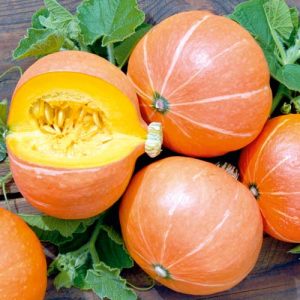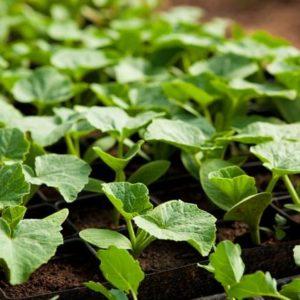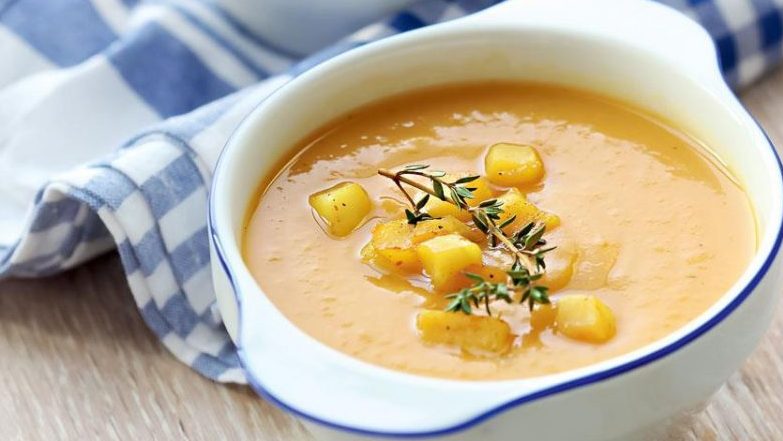Very compact and prolific pumpkin "Amazon" with crunchy sweet pulp: what is good and how to grow correctly
Pumpkin is not only a healthy vegetable, but also an essential ingredient for making sweet and savory dishes. It goes well with honey, apple, cinnamon and ginger. In order not to waste time looking for suitable pumpkins in the store, many people prefer to grow vegetables on their own.
One of the most popular varieties recognized as the Amazon pumpkin. Let us consider in detail how to properly plant an Amazon pumpkin and what is needed for this.
The content of the article
Description of pumpkin variety
The Amazon is a compact bush pumpkin that does not require much attention. The variety is early ripening, ripens within 90-100 days from the moment of planting. The shoots and stem are erect, so the crop retains moisture better under the bush and shows a stable high yield.

Distinctive features
The Amazon requires a minimum of space. The bushes have a classic green color, the fruits ripen at the base.
Amazon is not afraid of cold or drought, perfectly tolerates the main diseases of the culture. Many gardeners also note the decorative function of the variety; neat bushes with bright pumpkins will decorate any garden plot.
Fruit characteristics and yield
The fruits have a flat, rounded shape and a rich orange dense peel. The weight of one pumpkin varies from 1 to 2.5 kg. The pulp is very tender and juicy, with a bright yellow hue. Commodity and taste at altitude. Also, the vegetable is perfectly stored and tolerates transportation. Summer residents collect from 7 to 15 beautiful and tasty pumpkins from one bush.
Interesting! The pumpkin became known to people 8 thousand years ago. It was first tried by Indians from South America. Later, the culture began to be planted in all corners of the globe. The vegetable was not only eaten, but they also made dishes from it, weaved rugs from the peel, and also used flowers as decorations.
How to grow
Pumpkin is the most unpretentious melon crop, therefore, difficulties in planting and leaving are extremely rare. The Amazon variety is planted in two ways: seedling and non-seedling. What is the essence of each, we will consider below, and also pay attention to the features of plant care.
Planting with seeds
This method is more often used by gardeners from the southern regions of the country. For a seedless method, you will need seed material, a disinfectant and growth stimulants.
- Check seeds for germination... Place them in saline and stir gently. Those seeds that remain on the surface of the water are empty and are not suitable for planting.
- Disinfect the material using a solution of wood ash, at the rate of 2 tablespoons per 1 liter of water. Disinfection destroys dangerous microorganisms on the surface of seeds, and also increases the immunity of future plants.
- Temper the material within two days at a temperature of 1 degree.
- Place the seeds in a damp cloth bag and place in a warm place. After 2 days, add a growth stimulant such as succinic acid. It accelerates growth and increases pumpkin germination by 10%.
Fertile and loose soil is taken under the pumpkin. The plot must be protected from the wind and have a high-quality arable layer. The culture is planted after legumes, onions or herbs. And if you plant the Amazonka variety on a compost heap, then the vegetable does not need either loosening or weeding.Experienced gardeners recommend planting the Amazon in early May.
Planting seedlings
Prepare a nutritious soil for seedlings. Some summer residents prepare the composition on their own, using land from the garden, peat and humus. The disadvantage of self-prepared soil is that it must be disinfected with a solution of potassium permanganate. However, on the Internet there are often reviews that the purchased soil contains larvae and garbage. therefore Regardless of how the soil is prepared, we recommend treating it with manganese anyway.
Seeds are sown in dry and clean containers. This can be a wooden box or peat pot, a plastic cup, or a special cassette. The distance between the seedlings is at least 5 cm. The seedlings are stored in a warm and bright place, watered with a moderate amount of water every 5-7 days. After a couple of weeks, the sprouts are fertilized with liquid organic fertilizers, and after another 10 days the first mineral feeding is organized.
Important! Choose a cool morning for the seedlings. Before that, prepare the beds: burn all the garbage, dig up the soil, add peat and sawdust. The Amazonka variety loves a mixture of loamy and sandy loam soils.
Care
Use rainwater or settled water to water all pumpkin varieties: watering with cold water increases the risk of infection. Pumpkin beds are watered every 10 days. To avoid sunburn, perform the procedure early in the morning or in the evening. Periodically, ash or nettle is added to the water - thus, watering turns into a supplement that strengthens the immune system.
Also the Amazon pumpkin is weeded regularly. Weeding the beds involves removing weeds and loosening the beds. If this is not done, then the plant will quickly overgrow with weeds that live off the vegetable. The soil is loosened every 10 days, due to which the soil becomes airy, the access of oxygen to the pumpkin roots improves.
A necessary stage of care is plant feeding. Ideally, mineral complexes alternate with organic substances, so the bushes receive a balanced diet. From organic matter, summer residents prefer nettles, ash, garlic, onions. Solutions based on these products have a prophylactic and nutritious effect, increase yields.
Important! Pay special attention to nitrogen fertilizers. A solution of superphosphate, potassium salt and ammonium nitrate is recognized as an excellent tool. During the season, the bushes are fed with such a remedy twice, strictly observing the dosage. Also, many people use mineral complexes such as "Uniflor", "Juno", "Garden mixture".
Features of cultivation and possible difficulties
An excess of mineral and nitrogen fertilizers leads to a number of difficulties. Shoots begin to develop rapidly, and the fruits themselves remain small. Organics are fed after the appearance of the first two leaves, and minerals are used during the formation of the first ovaries. With the beginning of flowering, organic fertilizers are not applied. It is advised to feed the pumpkin with phosphorus-potassium fertilizers before the beginning of fruiting.
Also, watch the acidity of the soil. With its overabundance, the quality and taste of the fruit suffers noticeably. Add yeast or ash to reduce acidity. Watering based on them is recognized as an especially effective tool. In addition to root dressing, pay attention to foliar feeding. Spraying from a spray bottle additionally protects plants from unwanted insects.
Growing tips from experienced gardeners
To harvest a rich harvest, experienced gardeners recommend adhering to some rules. Their use protects the beds from diseases and improves the taste of the fruit.
- pumpkin is not planted after cucumbers, zucchini and squash;
- for the highest yield, the pumpkin is planted according to the scheme 2 x 2 meters;
- watering the vegetable not at the root, but in a ditch in the form of a circle;
- abundant watering is contraindicated, otherwise the fruits will begin to crack;
- fertilize bushes in strict accordance with dosages and manufacturer's recommendations;
- to increase yields, liming is carried out, which lowers the acidity of the soil and makes it more nutritious.
Many gardeners advise using a drip irrigation system. It moisturizes the beds evenly, saves water consumption, as well as improves photosynthesis and directs water directly to the roots. Use a drip system at any time of maturation. Also, the soil is loosened before watering. This way, water flows better into the soil, the root system develops faster.
Diseases and pests
Sometimes the Amazon pumpkin gets sick with bacteriosis. Due to the disease, the pumpkins become soft and begin to rot. Spots appear on the leaves, soon the whole bush dries up. As a preventive operation, use spraying with soapy water, which is prepared from 5 liters of water and 100 g of dry grated soap. The liquid forms a protective film on the leaves. If the culture is already sick, then spray the beds with a solution of copper sulfate, having previously prepared protective clothing and gloves.
Another common disease is called yellow mosaic. It appears as a bright yellow pattern on the leaves. Fruits are deformed and lose their presentation. For prophylaxis, pumpkin is treated with Pharmayod 3, and weeds and debris are removed from the beds in time.
Of the pests, slugs and whiteflies are noted, which appear due to high humidity and improper care. Wood ash is recognized as an excellent prophylactic and therapeutic agent. It is used both dry and as part of a solution with water.
Harvesting and application of the crop
The pumpkins are harvested when the stalk is hard and the leaves are dry and yellow. The pumpkins themselves become bright, and the peel is dense. Harvesting is recommended in dry weather.
The fruits are removed together with the stalk, so they are stored longer. If the weather is dry and warm, then the harvested crop is left for a couple of days in the beds. In the future, vegetables are stored in a dark place at a temperature of 5 to 15 degrees. An excellent storage space is a basement or pantry.
Interesting! Pumpkin contains a lot of vitamins and minerals. Vitamin A has a strong anti-aging effect and also strengthens hair and nails. Vitamins of group B have a beneficial effect on the work of the digestive system, eliminates gas formation. Also, pumpkin is rich in fiber, calcium, magnesium and iron. That is why the product is often recommended for people who adhere to proper and dietary nutrition.
The product has a peculiar sweetish taste. The vegetable is used to prepare side dishes and salads, which are combined with fish and meat dishes. Also delicious pancakes and pancakes are made from pumpkinwhich serve as a great dessert and are safe for the figure. In addition, the vegetable is actively used for making soups; the recipe with the addition of smoked meats is especially popular.

On a note! In Italy, pumpkin puree soup is prepared with the addition of cheese and wine, while in Haiti such a dish is an integral part of the festive table. In Australia, the soup is made very thick and a lot of spices are added to it, while in Afghanistan they make a milk soup with pumpkin called shirkavak.
Advantages and disadvantages of the variety
The Amazon variety is one of the easiest to care for, it does not require shaping and pinching the top. Care consists only in timely watering and feeding. Pumpkin gives a good and stable yield, has a high immunity, and has high taste. Also, the Amazon is perfectly stored and transported.
The variety has no significant shortcomings, only occasionally it gets sick and needs treatment.
Read also:
The benefits and harms of pumpkin for the body: the composition and properties of the vegetable.
The benefits and harms of steamed pumpkin.
Large-fruited variety with a positive name - pumpkin "Smile".
Farmers reviews
About the grade Amazon say different things.Sometimes summer residents are happy with the harvest, and sometimes, on the contrary, they are disappointed. What do Russian summer residents say about the variety?
Pavel, Moscow: “I have been growing the Amazon variety for a long time, and every year it makes me happy with an excellent harvest. Pumpkins are compact, neat, easy to cook. And you can't imagine a simpler variety in care, which I really like. I cook pumpkin juice or bake it in the oven. "
Dmitry, Kurgan: “I planted an Amazon pumpkin in the beds after the tomatoes on May 7th. Planted with seedlings, from mid-May he began to water the beds with rainwater. In general, the variety is not bad both in taste and in external qualities. "
Zina, Orenburg: “I heard a lot of controversial reviews about the Amazon variety, decided to test it myself and planted the seeds last year. The fruits set amicably, but the maximum weight of one was only 900 g. The shelf life was short, and within a month the harvested vegetables began to deteriorate. "
Conclusion
The Amazonka variety is great for those summer residents who do not yet have experience in growing pumpkins. Elementary care allows you to get the maximum yield with minimal effort. Small vegetables are stored for a long time, so they are often grown not only for personal consumption, but also for sale.
The Amazon will perfectly complement your morning breakfast and meat for lunch, as well as serve as the basis for an evening sweet pie.